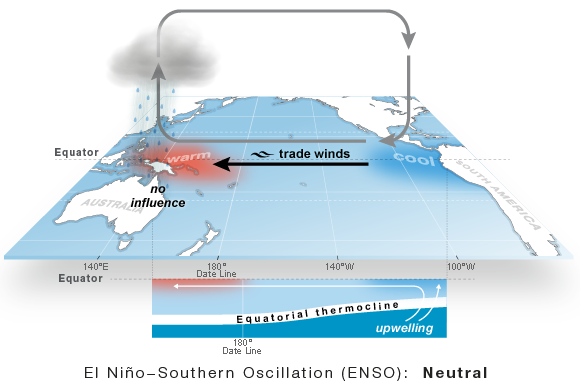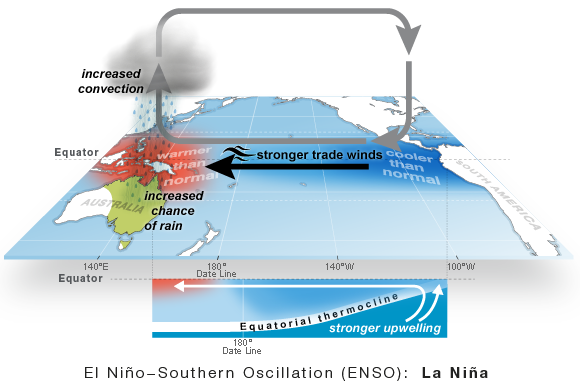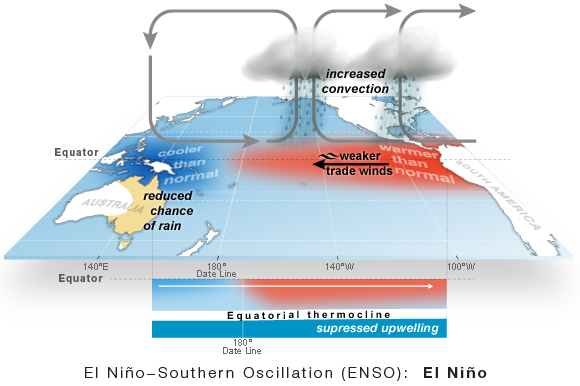Earth’s climate experiences regularly occurring changes. Some changes have a periodicity of tens of thousands of years like the ones relating to Earth’s orbit around the Sun. Some other changes are annual in nature like those relating to the seasons. Over these changes, a number of climatic oscillations are superimposed. These oscillations are comparatively less regular. For example, Millennial Climate Oscillations (MCOs) are sudden changes in Earth’s climate that happen regularly every 1,470 years.
The exact reasons behind these climate oscillations are not yet completely known. However, it is well understood that an oscillation taking place in one part of the world can potentially affect the weather pattern globally.
What is Climate Oscillation?
“Climate Oscillation (CO) is a regular / periodic back-and-forth change in climate of a region or the whole planet.”
There are three principal oscillations in Earth’s climate. These are:
| Climate Oscillation | Abbreviation | Region | Periodicity |
|---|---|---|---|
| El Niño/Southern Oscillation | ENSO | Southern Pacific Ocean | Three to Eight years |
| North Atlantic Oscillation | NAO | Northern Atlantic Ocean | One Decade |
| Pacific Decadal Oscillation | PDO | Pacific Ocean | Two-Three Decades |
Apart from the above mentioned three major oscillations, there are other smaller oscillations taking in place in the Indian Ocean, Arctic Ocean, and the Atlantic Ocean e.g. Arctic Oscillation, Atlantic Multi-decadal Oscillations, etc.
ALSO SEE: What is Climate Change?
El Niño – Southern Oscillation (ENSO)
ENSO is a natural periodically recurring cycle in the central and eastern Pacific Ocean. It strongly influences the global climate.
ENSO has three key phases:
- El Niño
- La Niña
- ENSO – Neutral
While El Niño and La Niña are extreme phases of the ENSO cycle, ENSO-Neutral is a normal phase lying between the two extreme phases. Generally, El Niño takes around four years to shift to the La Niña phase and vice-versa.
Neutral Phase
Steady trade winds blow across the tropical Pacific Ocean from east to west during a neutral phase. This event results in the piling-up of warm water in the western Pacific. Contrary to this western Pacific region, the water temperatures are comparatively lower in the eastern Pacific as the trade winds cause much cooler water to be drawn up from the deep. The difference in temperature in the tropical Pacific causes air to rise near Australia and descend near the South American continent. This results in a giant connected cycle called the “walker circulation”. This entire phase is referred to as the ENSO-Neutral Phase.

La Niña Phase
In a La Niña phase, the trade winds blow harder leading to the expansion of the warm pool on the western side (Australian side) of the tropical Pacific. It simultaneously results in the cooling of the oceans towards South America. This increases the difference between the temperature in the tropical Pacific making the walker circulation more strong. The trade winds start blowing equally strongly forming a “feedback loop”. Western Pacific witnesses greater evaporation, more clouds, and more rain due to higher ocean temperatures. This increases the risk of flooding, frequent tropical cyclones, and lower day-time temperatures in the Australian region.

El Niño Phase
El Niño is directly opposite to La Niña. During El Niño, the trade winds start to weaken and sometimes even gets reversed. This allows warmer water to drift back towards the eastern Pacific. The change in ocean temperature breaks the walker circulation leading to warmer water in the east and comparatively much weaker trade winds. As warm water shifts away from the western Pacific, it is followed by a shift in evaporation clouds and rains from the western Pacific. This results in a greater risk of drought in the Australian region, particularly the eastern and northern parts. It raises the temperature and we observe more heatwaves during El Niño.

Northern Atlantic Oscillation (NAO)
NAO is a weather phenomenon specific to the Northern Atlantic Ocean. It is the atmospheric pressure difference at sea level between (SLP) the Icelandic low and Azores High over a period of time. Sometimes the pressure difference is high and at the other times, it is comparatively low. This variation is the oscillation – the NAO.
This pattern of atmospheric pressure is usually the reason behind the westerly winds across the United Kingdom (UK). The difference in pressure is more during a positive NAO resulting in stronger westerly winds. It brings in mild air from the Atlantic region – resulting in mild and wet conditions and potentially stormy winds during winter in the UK.
During a negative NAO, the pressure difference is hardly noticeable. This means the weaker westerly winds paving way for the easterly winds to come in across the UK. Easterly winds result in cold-drier air during winter leading to a greater chance for a snowier season.
It is important to remember here that NAO only indicates the pressure set-up developed during a period. Through these indications, we tend to anticipate the type of winter in UK.
Pacific Decadal Oscillation (PDO)
PDO refers to the pattern of climatic events covering wide areas of the Pacific Ocean. It is very similar to ENSO except for the fact that it takes place over a much larger time span – 20 to 30 years!
During the positive/warm phase of PDO, higher sea temperatures are observed stretching towards the equator from the west coast of North America. High temperatures produce a horseshoe-shaped pattern that surrounds the central portion of the cooler surface waters in the north-western and central Pacific Ocean. The warmer surface water often results in breeding of Salmon Fish – a heavenly treat for fish suppliers from southern Alaska.
During the negative/cool phase, the pattern reverses. This time cooler surface water forms the horseshoe-shaped pattern surrounding the core of warmer surface waters. Cold PDO events have been associated with severe drought conditions spanning for a long period in the south-western USA and heavy-increased rainfall over the eastern Australian region.
Use the citation below to add this article to your bibliography
"Climate Oscillations: Definition, Periodicity, El Nino, La Nina." Dashamlav.com. Web. 13 June 2025. <https://dashamlav.com/climate-oscillations-definition-periodicity-el-nino-la-nina/>
Dashamlav.com, "Climate Oscillations: Definition, Periodicity, El Nino, La Nina." Accessed 13 June 2025. https://dashamlav.com/climate-oscillations-definition-periodicity-el-nino-la-nina/
"Climate Oscillations: Definition, Periodicity, El Nino, La Nina." (n.d.). Dashamlav.com. Retrieved 13 June 2025 from https://dashamlav.com/climate-oscillations-definition-periodicity-el-nino-la-nina/
